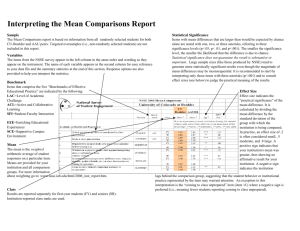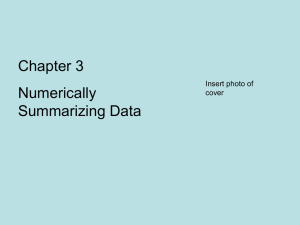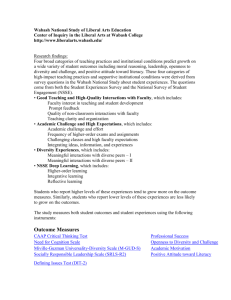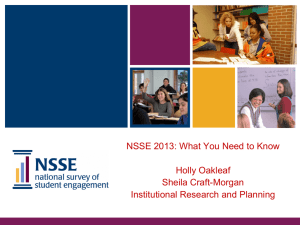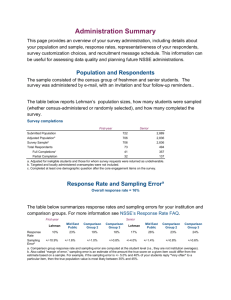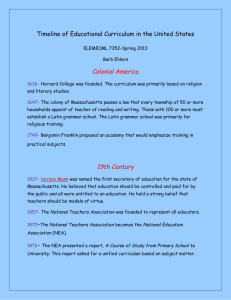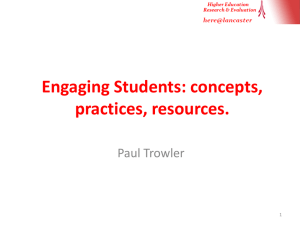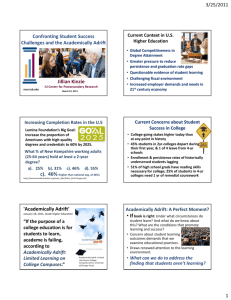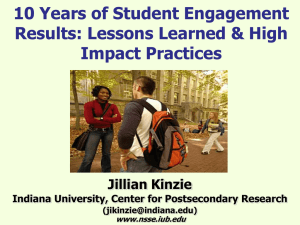gb re NSSE_FAQ
advertisement
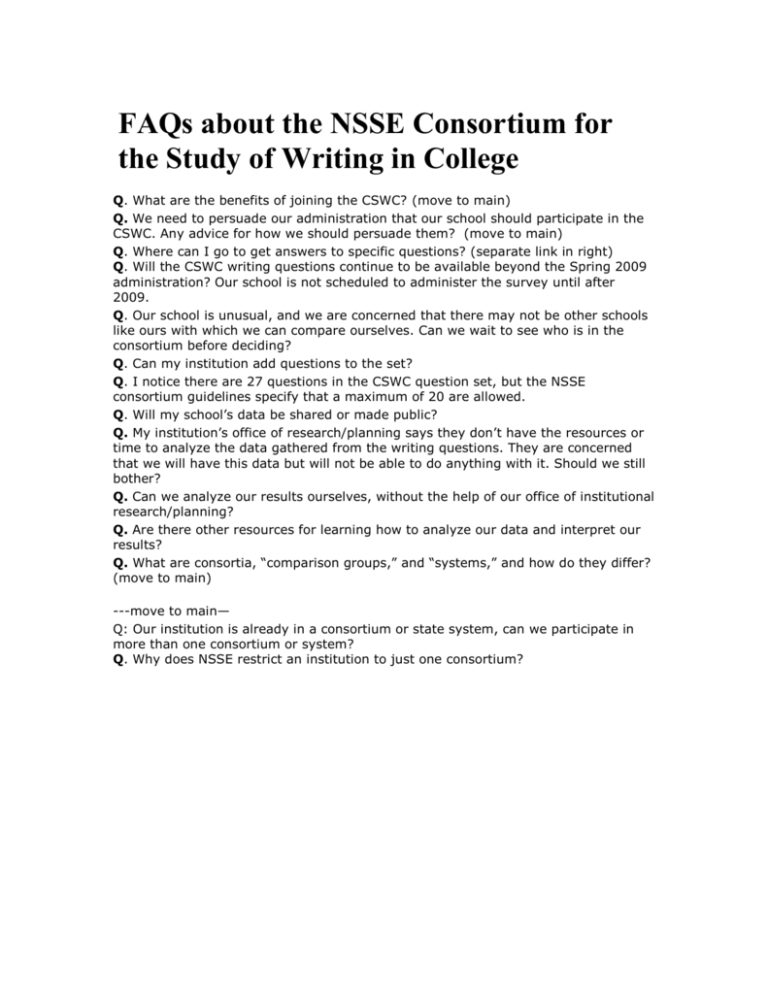
FAQs about the NSSE Consortium for the Study of Writing in College Q. What are the benefits of joining the CSWC? (move to main) Q. We need to persuade our administration that our school should participate in the CSWC. Any advice for how we should persuade them? (move to main) Q. Where can I go to get answers to specific questions? (separate link in right) Q. Will the CSWC writing questions continue to be available beyond the Spring 2009 administration? Our school is not scheduled to administer the survey until after 2009. Q. Our school is unusual, and we are concerned that there may not be other schools like ours with which we can compare ourselves. Can we wait to see who is in the consortium before deciding? Q. Can my institution add questions to the set? Q. I notice there are 27 questions in the CSWC question set, but the NSSE consortium guidelines specify that a maximum of 20 are allowed. Q. Will my school’s data be shared or made public? Q. My institution’s office of research/planning says they don’t have the resources or time to analyze the data gathered from the writing questions. They are concerned that we will have this data but will not be able to do anything with it. Should we still bother? Q. Can we analyze our results ourselves, without the help of our office of institutional research/planning? Q. Are there other resources for learning how to analyze our data and interpret our results? Q. What are consortia, “comparison groups,” and “systems,” and how do they differ? (move to main) ---move to main— Q: Our institution is already in a consortium or state system, can we participate in more than one consortium or system? Q. Why does NSSE restrict an institution to just one consortium? Q. What are the benefits of joining the CSWC? A. While colleges and universities have recognized the importance of writing throughout the curriculum, it has been difficult to understand how much and what kind of writing students are actually doing. The CSWC is designed to provide a snapshot the writing their undergraduates do. By participating in the consortium, schools can gather data about students' writing behaviors that would otherwise be impossible to acquire. Colleges and universities are increasingly dedicating new programs and resources that focus on student writing. These changes are led in part by the recognition offaculty, the public, and the professional world that writing ability is an essential skill for all college graduates. In addition, the research of Derek Bok, Richard Light, David Russell, and Marilyn Sternglass, among others, suggests also that writing activities increase students’ engagement and learning in any course. This movement is also driven by new concerns about students’ readiness to enter a global workforce with multifaceted, complex demands for communicative effectiveness. CSWC participants will receive a range of reports that idescribe students' responses to both the NSSE core survey and the additional question set about writing. Participants also receive the raw data, which they can use to answer their research questions about the role of writing at their institutions. For instance, institutions can examine the relationships between writing practices and the gains student report for a variety of other learnign outcomes. Benefits for first-year-writing programs and WAC/WID programs Paul/Chris For both first-year writing programs and WAC/WID programs, the CSWC question set asks questions that probably align with some or all of your program’s learning outcomes. Your NSSE results will provide an additional indirect measure of student learning, and could help you better understand what students are writing and how instructors are teaching writing, teaching disciplinary writing, or using writing to enhance learning. Benefits for departments, colleges, and other programs and units Individual departments and colleges can use the CSWC data to better understand the writing practices of their undergraduates. Individual departments, colleges, and other units can isolate the data for their students and examine their writing practices, and can even compare their students’ responses with students overall and from other units. If they request a special analysis from NSSE (which requires a fee), a unit could compare their students' responses wiht the responses of similar students from other institutions. For instance, a history department could compare their majors to the history majors from other institutions. Some units may choose to work with their offices of research/planning to analyze the data themselves Benefits for the institution Your institution’s office of research/planning is probably already aware that NSSE is a highly regarded and increasingly influential means for assessing student behavior and effective educational practice. If your institution is already administering the NSSE in Spring 2009, it can participate in the consortium for a very reasonable fee and gain an overall snapshot of students’ writing practice. These results, like all NSSE results, can be used for benchmarking: comparing an institution with other institutions or comparing your performance with pre-established goals. Institutions may be especially interested in using the CSWC survey results as part of their overall accreditation and accountability efforts. One of the most widely used assessment products for measuring value-added learning is the Collegiate Learning Assessment (CLA), which is designed to measure students reasoning and communication skills by assessing students’ written responses. Institutions that use the CLA may be especially interested in knowing what kinds of writing their students are doing. More Information about the CSWC Q. Where can I find more web-based information about the CSWC and NSSE in general? A. The clearinghouse site for information about the CSWC is at http://comppile.org/wpa+nsse. NSSE’s website includes several resources that can help you understand NSSE in general and consortia. NSSE webpage on consortia provides a general description of NSSE consortia, what they are, how they work, how to sign up, how much they cost, etc. Web tutorials about NSSE that you can listen to and watch are available at NSSE’s Webinar Archives. Q. Where can I go to get answers to specific questions? A. Email one of the following people with your questions. DOES ANYONE OBJECT TO HAVING THEIR EMAIL ADDRESS POSTED HERE? Chuck Paine, Coordinator of the Consortium, is an associate professor of English at the University of New Mexico. He’s the consortium factotum. Write to Chuck with general questions. If he can’t answer your question, he’ll direct you to the person who can. Paul Anderson, Consortium Collaborator, is Professor of English and Director of the Roger and Joyce Howe Center for Writing Excellence at Miami University (Ohio). Chris Anson, Consortium Collaborator, is University Distinguished Professor of English and Director of the Campus Writing and Speaking Program at North Carolina State University. Chris is a national leader in WAC/WID and assessment. Paul Chris Bob Gonyea, Associate Director of NSSE in the Center for Postsecondary Research, Indiana University-Bloomington, can can answer questions about Bob NSSE, data analysis, policy and procedures, and other stuff. , I think that actually we shouldn’t even list you here. I don’t think you want people calling you with data analysis questions, do we? Dan Bureau and Tony Ribera serve as managers for the consortium process. They can answer questions about consortium policies and registration. Dan/Tony Client Services Project Associates: Each institution is assigned two project associates who work as a client services team to provide support during your NSSE administration. You can view your institution’s project associates at http://nsse.iub.edu/html/staff.cfm. Client Services Manager Jennifer Brooks manages client services and can direct your question to the appropriate person at NSSE. Q. Will the CSWC writing questions continue to be available beyond the Spring 2009 administration? Our school is not scheduled to administer the survey until after 2009. A. There would need to be a consortium for the year you’re administering NSSE. The questions would not go away, but a single school could not use them alone; this is a NSSE rule. We can’t predict whether other schools would be interested in creating a consortium for 2010, but we think there’s a reasonable chance because many NSSE consortia continue across several years, because the CSWC has broad support from both the Council of Writing Program Administrators and NSSE. Q. Our school is unusual, and we are concerned that there may not be other schools like ours with which we can compare ourselves. Can we wait to see who is in the consortium before deciding? A. Yes. You can wait to enroll in the consortium until the closing date, October 5, 2008. If you write to Chuck Paine, he can we can tell you which institutions have told him they are enrolling. The CSWC Question Set Q. Where can I find the question set? A. You can get a PDF of the set of 27 questions at http://comppile.org/wpa+nsse/docs/27_Question_Supplement.pdf. Q. Can my institution add questions to the set? A. No. All member institutions of a consortium agree to use the identical question set. More questions could frustrate student survey takers and might lead to a drop in participation. Also, although your data will not be made public unless you choose to do so, all the data goes into an aggregate pool; if institutions added questions, the data would be rendered less commensurable. Q. How was the question set developed? A. It was developed through a multi-year collaboration between NSSE and the WPA. The WPA collaborators included more than 70 professors with expertise in writing program administration, writing across the curriculum, writing in the disciplines and writing-center theory and practice. Before and during the 2007 WPA Conference, these WPA collaborators created over 100 questions that were collapsed, refined, focus-grouped and finalized by a smaller team. More information about the development of the question set can be found on WPA/NSSE web pages (which are wrangled, designed, and maintained by Glenn Blalock at CompPile.org). Q. I notice there are 27 questions in the CSWC question set, but the NSSE consortium guidelines specify that a maximum of 20 are allowed. A. NSSE has given us permission to use the entire 27-question set. NSSE limits the number of questions because too many will frustrate student respondents and might cause some to give up on the survey. However, this question set appears to be relatively easy for students to complete. It was developed with the help of NSSE directors. Furthermore, the Spring 2008 experimental administration of the question set showed that students did not give up. Signing up to Participate: Costs, Dates, Procedures Q. How much does it cost to participate in the CSWC? A. The fee for consortia participation is based on overall undergraduate enrollment: Fewer than 4,000 $200 4,000 to 7,999 $300 8,000 to 12,000 $400 More than 12,000 $500 Q. What is the procedure for registering? A. Institutions will be sent an invitation to register in the consortium on or after September 5, 2008. Institutions must register by October 5. Q. When is the signup deadline? A. Institutions need to enroll by October 5, 2008. Data Analysis and Data Sharing Q. Will my school’s data be shared or made public? Bob A. , will you answer this? I answered for the person who asked but I’m sure you could do a better job. Q. My institution’s office of research/planning says they don’t have the resources or time to analyze the data gathered from the writing questions. They are concerned that we will have this data but will not be able to do anything with it. Should we still bother? Bob/Paul A. There may be good reasons to participate even if your research/planning office cannot complete an analysis of the data beyond what NSSE provides. Your office is right that you should consider what you want to do with this data. You will probably gain valuable information and insights from the analyses provided by NSSE (reports arrive in early August). But it is true, as your office suggests, that the most powerful results, conclusions, and insights can be gained when you match NSSE student responses with the kind of data that only your institution has access to, such as demographic data, student-success data (GPA, persistence, etc.), and data about programs and courses pursued by students. In short, matching institutional student data to survey data allows institutions to fine tune their analyses and discern with writing and other student experiences are leading to the learning, engagement, and success outcomes they are most interested in. Q. Can we analyze our results ourselves, without the help of our office of institutional research/planning? Paul A. : perhaps you could say briefly how an individual can do analysis themselves. You will need their help in getting access to the data, but you can do some analyses yourself, especially if you are assisted by a faculty member or graduate student with experience in social-science research. Q. Are there other resources for learning how to analyze our data and interpret our results? Bob A. : BOB you said you and Jillian were thinking about this. Have you been able to decide? Several helpful resources are available at NSSE’s Webinar Archives, especially “Getting Down to Basics: Working with your NSSE Data,” a twohour introduction to NSSE, its data, and uses. You could also read the 14-page PDF “Using NSSE Data.” Finally, if enough schools participate in the consortium, NSSE will conduct a webinar devoted to interpreting the CSWC survey results. The webinar will occur in October of 2009 (about three months after you will have receive your data from NSSE) and be produced and hosted by Associate Directors of NSSE Bog Gonyea and Jillian Kinzie. This will be a live and free webinar that you can participate in. It will also be available on the NSSE website for later viewing. General Information about NSSE Consortia Q. What exactly is a NSSE consortium? A. As NSSE explains on its website, “A NSSE consortium is a group of six or more colleges or universities participating in NSSE the same administration year that want to ask students additional questions that will follow the NSSE core survey.[…] You can see the diverse functions of NSSE consortia since the survey's inception in 2000.” Q. What are consortia, “comparison groups,” and “systems,” and how do they differ? A. Systems and consortia are kinds of comparison groups. Consortia ask additional questions; systems and ordinary comparison groups do not. Institutions register with systems and consortia in the fall before the NSSE administration; they select comparison groups in May, after the NSSE administration. Comparison group. Your institution can choose up to three comparison groups. Your survey results are compared to each of these three groups. As NSSE explains, “NSSE reports display results for each institution alongside three comparison group columns. Institutions have the option to customize each column or select a recommended default group of institutions. NSSE comparison groups may be customized in several ways. Contacts may identify specific institutions from the list of all current-year NSSE participants, create the list using institutional criteria, or begin with institutional criteria, then add or remove specific institutions to refine the comparison group.” Examples of comparison groups include institutions in your geographical area, in your Basic Carnegie Classification, CHE peers, and all other schools in the nation administering NSSE that year. System. One of your comparison groups can be a state or university system. Institutions can join a system at no additional charge. Systems do not ask additional questions; if they do choose to ask additional questions, they become by definition a consortium. Consortium. Up to one of your comparison groups can be a consortium. Institutions can join a consortium by paying an additional charge. Consortia ask additional questions. Q. Why does NSSE restrict an institution to just one consortium? A. This strict NSSE rule is designed to prevent "survey fatigue." Each consortium uses an additional question set. If students were asked to complete two additional question sets, many might feel overburdened or might give up. Q: Our institution is already in a consortium or state system, can we participate in more than one consortium or system? A: You can participate in only one consortium. You can participate in a consortium and state system only if the system is not asking additional questions. If you need clarification about a system, please contact Dan Bureau or Tony Ribera at consorti@indiana.edu i Q. Where can I find NSSE consortium general information? A. Visit this NSSE webpage on consortia. Convincing Your Institution to Participate in the CSWC Q. We need to persuade our administration that our school should participate in the CSWC. Any advice for how we should persuade them? A. Here are some ideas that might work. Choose those you believe will be compelling for your decision makers (upper-level administrators, directors of institutional research/planning, etc.). Perhaps most important, follow the principles of any good rhetorician and adapt your message to your specific audience and local situation. Explain how participation will benefit your school specifically. Connect the benefits of participation with specific initiatives and programs; connect to the specific local values and goals of your school, how it defines itself in its mission statement and similar documents; connect to the specific pressing needs and concerns your school faces. Connecting CSWC participation to the these typical ways that universities and colleges use NSSE core-survey results (from page 1 of NSSE’s “Using NSSE Data”): Assessment and improvement General education reform Benchmarking Alumni outreach Accountability Grant writing Institutional research Institutional advancement Accreditation & self-studies Faculty and staff development Retention Communication with students Institutional communication State system performance reviews Educate yourself about NSSE and the CSWC. Visit the WPA/NSSE website. Consult the first section of this document, “Benefits of Participating in the Consortium,” as an idea generator. Give yourself a crash-course tutorial about NSSE. View some of the webinars at NSSE’s Webinar Archives, especially “Getting Down to Basics: Working with your NSSE Data,” a two-hour introduction to NSSE, its data, and uses. It also provides numerous tips for talking with people in your college. You might also read the much shorter 14-page PDF “Using NSSE Data.” Also, scout around the NSSE website for information you think will be useful to you. Consider addressing how the CSWC might address these general highereducation issues: Assessment in general: the CSWC survey results may provide data about writing, which is a skill that those inside and outside higher education recognize as important; it would be difficult or impossible to gather this data in any other way. Accountability systems. If your school is participating in one of accountability systems (such as the Voluntary System of Accountability, which produces the College Portrait), participation and results could be reported there. Accreditation and self-studies for the institution. Accreditation and self-studies for departments and colleges. College deans and college directors of assessment can provide support. If your institution has a school of engineering, business/management, or education, those schools have professional accrediting agencies that have increasingly stressed the importance of writing skills. Accreditation and self-studies for other programs and units. Similarly, if you have a new or high-profile first-year-experience program that stresses writing instruction, enlist their involvement. Programs that might be especially interested in using CSWC results include: first-year experience, learning communities, WAC/WID programs, faculty development, various colleges that have professional accrediting agencies, administrators of large government and other grants, and others. National visibility by participating in a nationwide research project. Get written or oral support from deans, chairs, program directors, and other campus leaders. If you don’t have access to these campus leaders, speak with person in their unit who is in charge of assessment or of faculty development. Consider asking these campus leaders to demonstrate their support with money. You could ask them to commit to paying for a certain portion of the consortium fee. For instance, for the largest institutions, the consortium fee is $500, which could be split five ways. It would be a small but meaningful gesture of support. Ask these leaders to demonstrate their interest by indicating interest in oversampling their students. (NSSE’s “Oversampling Information” defines oversampling and explains why a school or unit would oversample.) Remind them that participation is relatively free of risk: the cost is very reasonable, and your school is free to do with the data as they wish, including keeping it to themselves.
